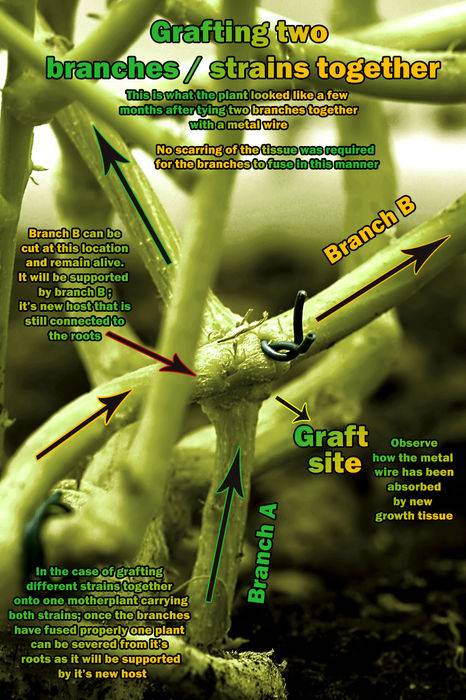Grafting cannabis is not a new thing, people experimented with grafting cannabis plants onto hops in the 70´s. This is however something that I stumbled upon while training my plants.
This picture is of a Super Silver Haze plant from my last grow. It was a bonsai mom that I trained for a long time, which included tying branches together at an early stage. One of the branches that I tied to another grafted with it's new host. The graft was more apparent from the other side but there was no way for me to get the camera into that jungle of branches.
Grafting is mostly a novelty of the plant world but the possibilities of grafting are endless, only limited by imagination. I suppose that there are three reasons for grafting; one is to fuse a scion with a host creating a multi-strain chimera in the process, the second is to graft a smaller plant onto a larger root system and the the third is to shape the plant itself.
I have been thinking about making a mother plant that holds many strains by grafting different strains together ever since I stumbled upon the works of an arborcraftsman named Axel Erlandson. Look it up, the things that he did is amazing..
People do this with apple trees and such and they said that the grafted plant produce fruit from all the species that were fused together and sometimes even new hybrids emerged spontaneously on new branches that grew after the grafting was done.
Grafting is usually done by making a transverse cut on both the host and the cutting that is to be grafted, then they stick the cutting into the cut branch and tie it all together. After that they keep ithe "wet graft" moist for several months until the "wound" closes up. Gardeners also graft saplings onto older and thereby greater root systems of different plants, usually improving greatly on vigor. This can be done with any plant as long as they are of the same family. People have even grafted tomato plants onto potato roots, creating a chimera that grows tomatoes above ground and potatoes underneath. Grafting rarely succeeds because it's such a long shot but if cannabis strains can be grafted just by tying branches together, this would be an easy and in effect low-stress way on doing it, which should have a greater chance of success.
Now I am at the point where I could give some more serious grafting a shot as I have a lot of clones to work with. As soon as I find the time I will look into this.
This picture is of a Super Silver Haze plant from my last grow. It was a bonsai mom that I trained for a long time, which included tying branches together at an early stage. One of the branches that I tied to another grafted with it's new host. The graft was more apparent from the other side but there was no way for me to get the camera into that jungle of branches.
Grafting is mostly a novelty of the plant world but the possibilities of grafting are endless, only limited by imagination. I suppose that there are three reasons for grafting; one is to fuse a scion with a host creating a multi-strain chimera in the process, the second is to graft a smaller plant onto a larger root system and the the third is to shape the plant itself.
I have been thinking about making a mother plant that holds many strains by grafting different strains together ever since I stumbled upon the works of an arborcraftsman named Axel Erlandson. Look it up, the things that he did is amazing..
People do this with apple trees and such and they said that the grafted plant produce fruit from all the species that were fused together and sometimes even new hybrids emerged spontaneously on new branches that grew after the grafting was done.
Grafting is usually done by making a transverse cut on both the host and the cutting that is to be grafted, then they stick the cutting into the cut branch and tie it all together. After that they keep ithe "wet graft" moist for several months until the "wound" closes up. Gardeners also graft saplings onto older and thereby greater root systems of different plants, usually improving greatly on vigor. This can be done with any plant as long as they are of the same family. People have even grafted tomato plants onto potato roots, creating a chimera that grows tomatoes above ground and potatoes underneath. Grafting rarely succeeds because it's such a long shot but if cannabis strains can be grafted just by tying branches together, this would be an easy and in effect low-stress way on doing it, which should have a greater chance of success.
Now I am at the point where I could give some more serious grafting a shot as I have a lot of clones to work with. As soon as I find the time I will look into this.




